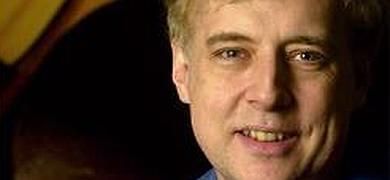
“Impress your friends with your understanding of the most recent theories for how life originated on Earth.”—Steve Benner, FfAME (black diamond---carbon; olive green peridot---the serpentinizing mineral; pink tourmeline delivering borate; blue apatite delivering phosphate)

STEVE BENNER, Photo: NASA
Five years ago at an origins of life conference at Princeton University, I suggested to Andrew Pohorille--- NASA’s senior-most scientist on the subject of origins, and synthetic biologist Steve Benner---who runs his own non-profit research institute in Florida, that they take the origins discussion to public television like Paul Nurse did with science, bringing in Pfizer to sponsor a 13-part program on Charlie Rose. Pohorille at the time thought the subject was “too esoteric” for public television. Benner liked the idea and I received an email from him several months later while on Crane Island in the San Juans saying that he was almost booked on Charlie Rose. But initial interest was in Benner’s findings on primate evolution and the consumption of alcohol, and his guest spot never did materialize.
With the Charlie Rose Show now swept away by scandal, and PBS late night television without a suitable replacement really, Benner has recently taken to the stage on Manhattan’s Lower East Side (admission $20@) to discuss origins of life at a performance space described as a cross between the Harvard Club and CBGB. I’m told the podcast of the event will soon be publicly available.
Benner is one of few scientists with that kind of range. Britain’s Nick Lane, a biochemist at University College London and popular science writer, is another. Lane is known to Irish fiddle in pubs on weekends and has recently been coaxed onstage to play with origins of life---sans fiddle. But origins of life with fiddle could also draw a crowd. So could an opera with full orchestra.
Steve Benner is a self-described “crackpot synthetic biologist to some extent” (i.e., he thinks outside the box). As an entertainer, he’s got perfect timing. His father was an inventor and engineer and his mother a musician. But Benner’s wit is uniquely his own. For instance, one way he’s raising money for origins research is through the sale of origins jewelry, as FfAME, his non-profit foundation, advertises:
“Impress your friends with your understanding of the most recent theories for how life originated on Earth. Each necklace is individually handcrafted by Mary Margaret Andrew, with a black diamond representing carbon (the central element in RNA, which originated life), pink tourmaline (delivering borate needed to stabilize ribose, the “R” in RNA), blue apatite (delivering the phosphate of RNA), and olive green peridot (the serpentinizing mineral that provides the alkali that gets it all to work together).”
Benner’s outreach is not as unconventional as it may seem, however. He’s managed to secure a $5.4 million grant from the Templeton Foundation for origins research. In Benner’s announcement of the Templeton award on his FfAME web site, he credits Harry Lonsdale for getting the origins research funding ball rolling with some of “his personal fortune,” and NASA for its ongoing support for astrobiology. Benner had this to say about the Simons Foundation, which is now substantially throwing money into origins investigations:
“The Simons Foundation portfolio is largely classical, devoted mostly to research strategies that were defined a half century ago. We are hoping in our Templeton program to support more innovative ideas, ideas that have a chance of solving paradoxes related to origins that will remain even if all of the classical questions are answered.”
It is curious that Benner’s appearance on the Downtown Manhattan stage was sponsored by the Simons Foundation. And even more curious that the host of the show---who writes for the New York Times---still believes in tooth fairies like natural selection.
Speaking of tooth fairies, as previously noted here, for the past two years NASA and Templeton have funded religious scholars in a $3 million inquiry about how the religious community would respond to the discovery of life in outer space. The sole representative from NASA to that inquiry was Frank Rosenzweig, apparently the grandson of Franz Rosenzweig, the Jewish theologian who, with Martin Buber, translated the Bible into German. The irony is that there are a significant number of scientists at NASA, I’m advised, who don’t think we will find life anywhere else in the solar system. And I’m further advised that the instruments to detect biomarkers on the exoplanets are “decades away” from development. Not to mention the lack of consensus about what life even is. . .
Benner is now scheduled to address origins funding options at the January 14-19 Gordon Conference in Galveston, Texas, as well as discuss how to commercially spin off origins research. To shed further light on Benner’s strategic thinking along these lines, following are excerpts from our 2013 Princeton conversation, featured in my book, The Origin of Life Circus: A How To Make Life Extravaganza.
January 2013, Princeton
Suzan Mazur: I was just stepping into the discussion about origin of life in 2008. I thought it was important to talk to a diversity of people, including amateurs and mavericks, because who knows where the great idea comes from.
Steve Benner: Exactly. As I mentioned and you quoted me, none of us are experts and we don't really know what we're doing with this.
Suzan Mazur: Since the Princeton conference is about the RNA world, would you comment as to whether you think things in the RNA world have moved significantly forward in the last few years?
Steve Benner: Yes. They really have. In part, because there's been a swing back and forth between two major themes. One theme emerged in the 1980s, the discovery of catalytic RNA, which led the community, myself included---I was just a pup at the time---to think the problem was a lot simpler. The discovery by Sid Altman, Tom Cech, Norm Pace and various people, that there was a potential for RNA being a catalytic molecule was certainly something.
It went back a lot earlier. Carl Woese had this on his mind. You can go all the way back to Alex Rich in 1962. As far as I know, Rich was the first person to actually suggest RNA could perform both the catalytic and genetic roles.
I thought it would be a much easier process. By the 1990s it was quite clear---as evidenced by Stanley Miller's paper from 1995 or 1996---that it was going to be a hard slog to get RNA in its oligomeric form because of the instability of its various pieces. Again, a downer from the 1960s when people were finding prebiotic ways, all sorts of things based on Stanley Miller's earlier work.
Leslie Orgel was one scientist. Joan Oró. All these people found lots of these things going on quite quickly. But in the 1990s we hit another wall with the research. And by the year 2000 scientists were saying -- like my good friend Pier Luigi Luisi, who you've noted has referred to the RNA world as a baseless fantasy. Luigi and I were colleagues at the ETH in Zurich for 10 years, by the way. In the 1995-2000 period, scientists were in despair.
Suzan Mazur: But Luisi is up to date about developments in the RNA world.
Steve Benner: The way he states the case is probably a bit stronger than he actually himself believes. All of us do this in speaking to the Fourth Estate.
Suzan Mazur: He told me something even worse.
Steve Benner: Even worse?!
Suzan Mazur: I asked Luisi if funding was the issue slowing down progress in the origin of life field. He said that is not the problem. Luisi said there are no new ideas, we need "mindstorms."
Steve Benner: There is a shortage of ideas plus there's a shortage of funding to pursue the ideas that we do have. It's an interesting question whether putting more money in will result in more substantial ideas. It's a cycle you can't anticipate, you have to try. . .
Suzan Mazur: Lonsdale wanted to go really public with the origin of life message. He saw that I'd been on the Charlie Rose Show and asked if I could introduce him. I told him what I knew in terms of doing science roundtables these days on the program, which is what Paul Nurse told me in 2008 at his Rockefeller University Evolution symposium. That is, if you want to do a science roundtable on Charlie Rose, you need a corporate sponsor like Pfizer, which Nurse brought in for his 13-part series.
Steve Benner: I didn't know that.
Suzan Mazur: Some think orign of life is too esoteric a subject for a public discussion, but Princeton and NASA made the wise decision to stream the Princeton conference over the Internet. I think Lonsdale is right. There should be a series of Charlie Rose origin of life roundtables.
Steve Benner: I agree.
Suzan Mazur: Luisi says there are no new ideas. Why not widen the discussion circle? Freeman Dyson was on Charlie Rose talking briefly about origin of life. Why not bring Freeman Dyson in again and many others for an in-depth conversation?
Steve Benner: Science, to the public, is at one level the memorization of facts based on an authority -- your teacher, who has the cosmic authority of the expert. You'll see this all over -- "four out of five dentists agree." The appeal to authority and consensus of opinion.
But science is also the opposite. I'm a great fan of Richard Feynman who comments that science begins with a denial of the opinion of experts. Science begins when you say NO. The perceived wisdom is wrong. Feynman's opinion is exactly the opposite of what many people think science is, the memorization of facts taught to you by an authority.
Suzan Mazur: That was the view of the late science and technology historian David F. Noble, who told me, "A consensus of scientists. Well, when you have a consensus of scientists, that should set off alarms."
Steve Benner: Scientists must be trained. This is a problem. Feynman goes on to point out that there's an enormous amount of what goes on in the public sphere in term of science that is mostly not scientific at all. He also says there's an enormous amount of intellectual tyranny in the name of science.
Suzan Mazur: Noble thought that peer review was at the heart of the problem. He considered it censorship.
Steve Benner: Well, it's a big problem. I'm a very soft peer reviewer. I think if you want to publish something that makes you look like a fool -- go ahead. Be my guest.
Suzan Mazur: Yes. You have a right to put it up there. Lynn Margulis courageously fought PNAS over its system of anonymous peer review.
Steve Benner: Exactly. This is how I don't get asked to review very often. . . .
Suzan Mazur: So is the origin of life field exploding within the scientific community?
Steve Benner: We now have the ability to address most if not all of the 1990s objections to the RNA World. That means we have ways to get ribose directly. We have ways to get ribose and its nucleotides indirectly. Some of that progress is due to the work of Sanchez and Orgel. Some of these are very old ideas. John Sutherland has amplified these splendidly. There is essentially nothing from the 1995 critique of the RNA world that does not have an answer.
Suzan Mazur: But it will be a creation scenario that COULD have happened. Not what did, in fact, happen.
Steve Benner: There is this general question when the science experiment ends. Peter Galison has written a book, How Experiments End. Nothing is ever proven in science. At some point the community decides this is no longer the most pressing problem. That's it. The investigation moves on from this to that.
It's a matter of opinion as to whether the solutions to the 1990s’ objections regarding the RNA world are sufficiently robust to allow people to move on from them to something else. It is a little early to say that. Right now what's emerging in the RNA world, which Irene Chen talked about here at Princeton, is that we don't know how useful function is distributed among sequence spaces.
You have 4 raised to the power 100 different sequences of RNA 100 nucleotides long. We don't know how productive function is distributed there compared to destructive function.
One of the things about the model of autocatalysis is that we have many molecules and this increases the chance of having one that does something productively but it also increases the chance of doing something else destructively.
Well, very often when you add things, it's bad. It destroys interaction. It inhibits interaction. It catalyzes undesirable side reactions. It depletes material. . . .
Suzan Mazur: Are you involved in making a protocell?
Steve Benner: We're not. There are a lot of very bright people in that business. A lot of them are in Europe.
Suzan Mazur: Are scientific fields here in the US integrating as they are in Europe?
Steve Benner: I saw a piece of yours a while back about the CERN meeting coming up. Partly because of the European funding structure, which we got a taste of in Antonio Lazcano's talk regarding Mexico. Lazcano said that if you are a professor, you have a chair which has an endowment associated with it so you have a certain amount of research without having to go outside. It makes people lazy and that's one of the criticisms Americans will direct at the European system. But it also permits imagination and broad-based interest.
If you go to France, you see people coming up with cutting-edge advances in sort of this evolution fringe.
Suzan Mazur: This is good.
Steve Benner: Of course it's good.
Suzan Mazur: Well there could be more public interest and more funding in the US. How do you get the public enthused? Do a 13-part series on origin of life on Charlie Rose.
Steve Benner: All of this is coming from Europe. I had 10 years in Europe where I had the ability to do crackpot things. It is because of the funding structure in Europe.
I worked for 10 years in Switzerland at the Swiss Federal Institute of Technology, and I was the beneficiary of the European funding system, for which I'm eternally grateful, and for which major advances came out that would not have been conceivable at all in the United States.
You heard Eric Goucher's talk here at Princeton, where he was resurrecting ancient enzymes. We were the first people to do that, we did that in Europe. We would never have done that in the US. I proposed that to the NIH when I was just a pup in the mid 1980s, but the NIH panelist reviews were scathing. And I've kept them.
The second thing is that we reinvented the genetic alphabet. Put 12 letters into DNA and the four ACTG. But go around the world and ask where has synthetic biology expanded on the notion of what might constitute a genetic system. Well in Belgium there's Piet Herdewijn. You go to Albert Eschenmoser at ETH in Zurich, my former laboratory. This is all coming from Europe. There is nothing of this power originating in the United States.
Suzan Mazur: But you're a synthetic biologist now in America.
Steve Benner: That's right. A crackpot synthetic biologist to some extent. Synthetic biology is now mainstream. It was certainly not mainstream in the early 1980s. Or in the 1990s when Piet Herdewijn was getting started in Belgium.
It was only because of the funding structure of Europe where you were allowed to bring together---you were mentioning this in the protocell area, but this is 20 years ago---the molecular biology needed to do this, the synthetic organic chemistry needed to do this, the physical chemistry, the biophysics, this concept about origins of life to inspire. You didn't see that anywhere in the United States until after Europe took the lead. That is a direct assignment, you can attribute that directly to funding.
